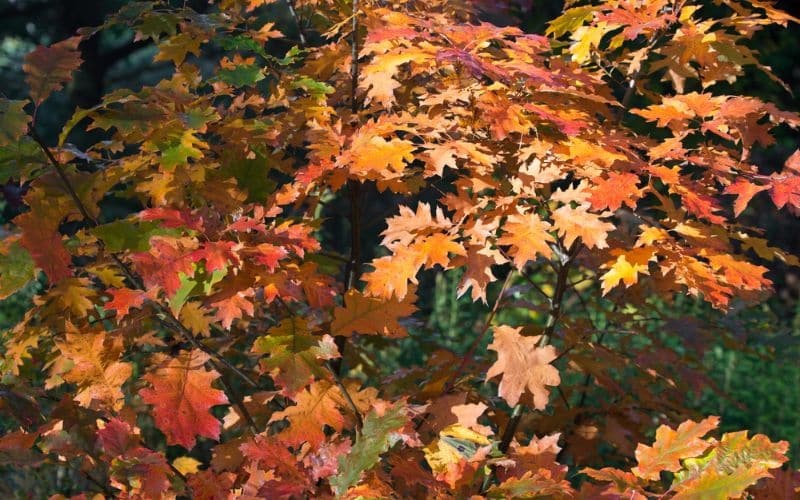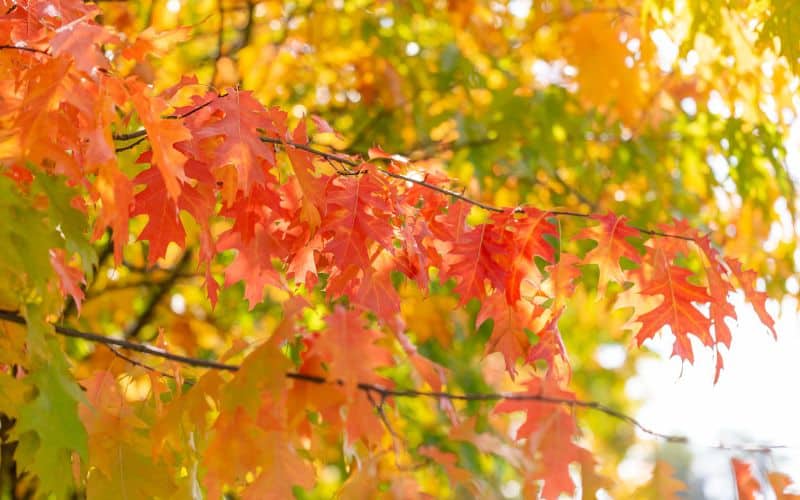
Ontario’s landscapes are rich with a diverse range of tree species, but one that stands out is the Red Oak. This native deciduous tree, scientifically known as Quercus rubra, has become a significant part of Ontario’s identity. Majestic in its appearance and resilient by nature, it adds charm to your surroundings while offering numerous environmental benefits.
You’ll often spot Red Oaks adorning parks, lining streets or even in private gardens across Ontario. It can reach impressive heights of up to 30 metres and boasts leaves that transform from a vibrant green hue in summer to fiery red tones come autumn – hence its name. Known for its strength and hardiness, the Red Oak thrives best under full sun exposure and well-drained soil conditions.
So why should you consider incorporating this magnificent tree into your landscape? Apart from enhancing aesthetic appeal with their beauty year-round; these giants also provide habitats for various wildlife species like birds and squirrels – playing an integral role within our ecosystem.
Exploring the Splendour of Red Oak in Ontario
Ontario’s natural beauty is on full display when you venture into its dense forests. Right at the heart of this splendour, you’ll find an abundance of red oak trees. These majestic giants are a sight to behold and play a crucial role in Ontario’s ecosystem.
You might wonder why these particular trees command such attention. Well, it’s because they’re not just any old tree – they’re Quercus Rubra or Red Oak, as we commonly know them. With their size reaching up to 30 metres and lifespan stretching over centuries, there’s no denying their impressive stature.
Let’s delve into some fascinating facts about red oaks:
- Age: A typical red oak can live up to 500 years.
- Height: They can grow anywhere from 20m to 30m tall.
- Leaf shape: The leaves have distinctive lobes with points that create an iconic silhouette against the sky.
Red Oaks aren’t merely beautiful; they serve a purpose too! From providing habitat for wildlife like squirrels and birds who call these mighty structures home, all through offering shade during those sweltering summer months – they’re more than just eye candy for nature lovers.
The acorns produced by these trees provide nourishment for various animals including deer and rodents. But it doesn’t stop there; even humans find value in Red Oaks beyond their aesthetic appeal – think fine furniture or sturdy flooring!

Understanding the Ecology of Ontario’s Red Oak
Delving into the ecology of Ontario’s Red Oak, you’ll find it fascinating. This majestic tree species, scientifically known as Quercus rubra, is native to North America and thrives in Ontario’s diverse climate.
The red oak is a hearty survivor. It can withstand various weather conditions that are typical for Ontario – freezing winters and hot summers aren’t a problem for this robust tree. Its resilience doesn’t stop there either; red oaks have an impressive ability to adapt to different soil types ranging from sandy or gravelly soils to clayey ones.
Here’s something truly unique about these trees: they’re deciduous! Yes, their leaves change colour throughout the year adding a beautiful array of hues during autumn before falling off in winter only to regrow again come springtime.
As for wildlife interaction? You’d be surprised how integral red oaks are within their ecosystem:
- They provide habitat and food sources for numerous birds like woodpeckers and owls.
- Mammals such as squirrels rely on them too – primarily feasting on acorns.
- Even insects get in on it with some species using the bark as a safe haven!
Now let’s touch upon growth rates because these giants don’t just appear overnight! On average they grow 60 cm per year reaching heights up-to 30 metres (100 feet). If you’re wondering how old your neighbourhood red oak might be – here’s an interesting fact: A mature one could easily be over 200 years old!

Caring for Your Red Oak
Planting a red oak in your Ontario garden? Here’s what you need to know. These hardy trees are native to North America and thrive best in the eastern and central parts of the continent, including right here in Ontario.
Firstly, consider their preferred growing conditions. Red oaks appreciate full sun exposure – that’s six hours or more of direct sunlight each day. They’re not too picky about soil type but will grow fastest in well-drained sandy or silty soils.
When it comes to watering your red oak, it’s important not to overdo it. Established trees are fairly drought tolerant and usually only require additional water during prolonged dry spells. On average, providing around an inch of water per week should suffice.
Here’s a few key points on maintaining healthy growth:
- Regular pruning is essential – aim for late winter when the tree is dormant.
- Keep an eye out for pests like gypsy moths or diseases such as oak wilt.
- Mulching can help maintain moisture levels and suppress weed growth.
Growing these magnificent trees may seem daunting at first but don’t be discouraged! With patience and proper care, your red oak can become a long-lasting fixture enhancing both aesthetics and biodiversity within your landscape while contributing significantly towards local ecosystems by providing food sources for numerous bird species among other wildlife residents.
Lastly remember that caring properly for mature oaks isn’t just about keeping them looking good; they’re vital components within our ecosystem offering benefits from carbon storage capabilities through supporting diverse wildlife populations too!
The Economic Impact of Red Oaks in Ontario
Ontario’s landscape is graced with the majestic presence of red oaks. But did you know these stately trees aren’t just a sight for sore eyes? They’re also big contributors to Ontario’s economy. Here’s how.
Firstly, let’s talk timber. Red oak wood is highly valued in construction and furniture industries due to its durability and attractive grain patterns. You’ll often see it used for flooring, cabinets, and high-quality furniture pieces that are built to last generations.
| Industry | Use of Red Oak |
|---|---|
| Construction | Flooring |
| Furniture | Cabinets, High-Quality Furniture |
Secondly, red oaks play a critical role in supporting the province’s tourism sector as well. Autumn foliage tours bring thousands of visitors each year who want to marvel at the stunning fall colours displayed by our local flora – with red oaks being one of the star attractions!
Thirdly, don’t forget about carbon sequestration! Yes, you heard right – these leafy giants help combat climate change by absorbing CO2 from our atmosphere as they grow.
- Each mature oak tree can absorb approximately 22 kg CO2/year.
- This equals removing around 0.5 cars off Ontario roads every year per tree!
Moreover, they’re job creators too! From arborists who care for them on city streets or parks; loggers who harvest their timber sustainably; craftspeople making beautiful wooden items out them – all depend on healthy red oak populations for their livelihoods.
Conclusion: The Lasting Legacy of Ontario’s Red Oaks
You’ve journeyed with us through the vast expanses of Ontario, exploring the majestic beauty and historical significance of its red oak trees. Now it’s time to reflect on what we’ve discovered.
Ontario’s red oaks are more than just trees; they’re monuments to Canada’s natural heritage, standing tall for centuries and contributing significantly to our ecosystem. They’re home to countless species, acting as a hub for biodiversity that keeps our environment balanced.
- Red oaks provide shelter and food for numerous wildlife species.
- Their leaves contribute nutrients back into the soil when they decompose.
- Mature red oaks can absorb up to 150kg of carbon per year, playing an essential role in climate regulation.
The importance these giants hold is evident in their protected status across much of Ontario. Yet despite this recognition, threats such as urban development and climate change continue to loom over them. This serves as a poignant reminder that conservation efforts need constant attention if we want future generations to experience these magnificent landmarks too.
As you look around your own neighbourhood or embark on your next hike through one of Ontario’s many forests, remember how vital these towering sentinels are – not just aesthetically but also ecologically. Encourage local authorities where necessary towards preservation initiatives because every single tree makes a difference!
Indeed, preserving the legacy of Ontario’s red oaks is everyone’s responsibility – from government bodies down to individual citizens like you! By appreciating their value today we ensure their continued existence tomorrow — making sure that future generations will marvel at those stunning autumn hues cascading from branches high above long after we’re gone.
After all isn’t it amazing how one tree can inspire so much? So let’s keep nurturing this lasting legacy together! Let’s strive together ensuring that every acorn sown today becomes tomorrow’s mighty oak!








